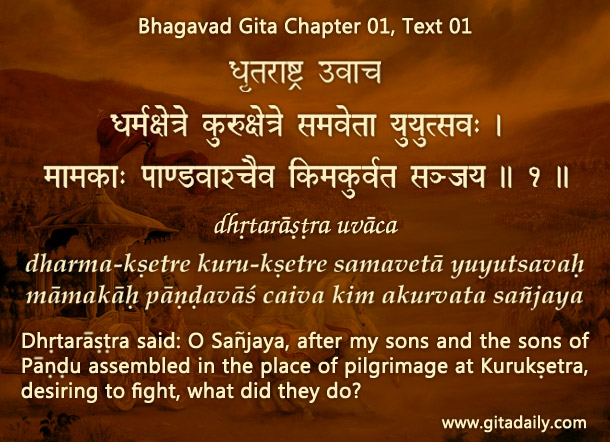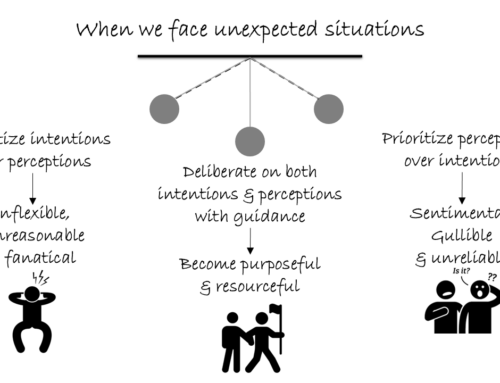To equate what we don’t want to see with what we can’t see is the essence of self-deception.
We humans have an amazing and alarming capacity to to deceive ourselves. We often believe things we could easily have detected and rejected as lies if we had just taken the time to contemplate them. Of course, the world is complicated, and there are many forces of illusion designed to keep us from seeing certain things. The Bhagavad Gita points to the illusory force called maya, which distracts and distorts our vision. Due to the influence of this illusory energy, we cannot presently see spiritual reality, even though we are spiritual beings and the spiritual domain is far greater than the material domain.
While there are certainly things worth seeing that we just can’t see because of our present condition, there are still many things we can see if we wanted to—but we just don’t want to see them, either by conscious decision or by subconscious preference. For example, we all can sense the inadequacy of sensual indulgence in ever providing a life of satisfaction. After all, even if we had the best sense objects readily available to us, the pleasure they offer is, by nature, limited to a few moments or, at most, a few minutes. How can a life dedicated to sense pleasure ever be a happy life?
Although this can be understood with some sustained reflection, we often choose to believe the world’s propaganda—that if we only had better sense objects, we would enjoy life so much that it would feel like paradise. Believing this notion is not a blindness imposed on us but a blindness chosen by us and even preserved by us.
The Bhagavad Gita begins (1.1) with a question by the blind king, Dhritarashtra, whose very question reveals that his blindness goes far beyond the physical blindness imposed on him by nature. Dhritarashtra has chosen to let himself be blinded by his attachment to his son. Thus, he sides with his son, despite knowing that his son is on the wrong side in the upcoming war and will likely cause the destruction of their entire dynasty if he doesn’t intervene and stop his son’s actions.
Later on in the Bhagavad Gita, Arjuna also becomes blinded by affection, compassion, and confusion, but his blindness is cured when he hears the wisdom of the Gita. Dhritarashtra’s blindness, however, is not cured by the Gita’s wisdom because the blindness is not holding on to him—he is holding on to the blindness.
We may not be as willfully blind as Dhritarashtra, allowing an entire dynasty’s destruction while we stay passive, but we too have attachments that we passively consent to, letting them blind us. The more we recognize and reject the blindness we have accepted and start seeing the things we can see through education and contemplation, the more we can commit ourselves to spiritual practices that can eventually cure our spiritual blindness and enable us to see spiritual realities, such as the indestructible soul and the infallible Lord, of whom the soul is an eternal loving part. It is this vision and the life of love that brings our hearts the ultimate fulfillment.
The more we strive to see the things we can see at present, the more we will be able to see the things we currently can’t see. The more we fight against our chosen blindness, the more we will be freed from our imposed blindness.
Summary:
- We succumb to self-deception, as did the blind king, Dhritarashtra, in the Mahabharata, when we equate the things we don’t want to see with the things we can’t see—when we equate accepted or chosen blindness with imposed blindness.
- The imposed blindness is our inability to see spiritual reality in our present materially embodied condition, whereas the chosen blindness is our unwillingness to see the inadequacy and futility of a life devoted to the pursuit of sensual pleasures.
- The more we strive to see what we can see by rejecting the blindness we have accepted, knowingly or unknowingly, the more we will be blessed through our spiritual vision to see what we can’t presently see by curing our imposed blindness.
Think it over:
- How does Dhritarashtra demonstrate the two kinds of blindness?
- Contemplnjm bvcvbnate one truth about the nature of a particular material pleasure that you do not want to see, and list three tangible steps by which you can help or even force yourself to see that truth.
- How can seeing what we can see enable us to eventually see what we can’t see?
***
01.01 Dhṛtarāṣṭra said: O Sañjaya, after my sons and the sons of Pāṇḍu assembled in the place of pilgrimage at Kurukṣetra, desiring to fight, what did they do?



Leave A Comment